2
The U.S. Social Security Administration Disability Process
The U.S. Social Security Administration (SSA) provides benefits to adults and children who meet the eligibility requirements for a disability described in Title II and Title XVI of the Social Security Act. The Social Security Act defines a disability as the inability to engage in substantial gainful activity by reason of any medically determinable impairment or impairments—physical, mental, or combination—that can be expected to result in death or which has lasted or can be expected to last for a continuous period of not less than 12 months.1
Disability benefits are provided through two federal entitlement programs: Social Security Disability Insurance (SSDI) and Supplemental Security Income (SSI). The SSDI program, established in 1956 by the 1954 amendments to Title II of the Social Security Act, provides benefits to eligible adults (less than the full retirement age) who have paid Social Security taxes for a sufficient number of years in jobs covered by Social Security and who are unable to work because of severe long-term disabilities; it also provides benefits to their dependents. In addition, the SSDI program
___________________
1 The formal SSA definition of disability is described in Section 223(d)(1) of the Social Security Act, as an “inability to engage in any substantial gainful activity by reason of any medically determinable physical or mental impairment which can be expected to result in death or which has lasted or can be expected to last for a continuous period of not less than 12 months, or in the case of an individual who has attained the age of 55 and is blind (within the meaning of blindness as defined in section 216(i)(1)), inability by reason of such blindness to engage in substantial gainful activity requiring skills or abilities comparable to those of any gainful activity in which the individual has previously engaged with some regularity and over a substantial period of time” (Social Security Act, 42 U.S.C. § 423(d) (2011)).
confers eligibility for Medicare coverage after a 2-year waiting period. The SSI program, authorized by Title XVI of the Social Security Act and enacted in 1972, is a means-tested program based on income and financial assets that provides income assistance from U.S. Treasury general funds to adults aged 65 and older, individuals who are blind, and adults and children with disabilities. To qualify for the program a claimant must, in addition to establishing disability, meet nonmedical income and resource eligibility requirements, which are based on need. SSI recipients are also eligible to receive Medicaid coverage (without the waiting period required with SSDI and Medicare coverage).2
DISABILITY CONCEPTS
The concept of disability has evolved over the past several decades from a solely medical model to a biopsychosocial model, as has been described in previous National Academies of Sciences, Engineering, and Medicine (the National Academies) reports such as The Dynamics of Disability: Measuring and Monitoring Disability for Social Security Programs (IOM and NRC, 2002), Workshop on Disability in America: A New Look: Summary and Background Papers (IOM, 2006), and Functional Assessment for Adults with Disabilities (NASEM, 2019). The World Health Organization’s International Classification of Functioning, Disability and Health (ICF) framework describes disability as “an umbrella term for impairments [of body functions or structures], activity limitations and participation restrictions” that arises from “the interaction between an individual (with a health condition) and that individual’s contextual factors (environmental and personal factors)” (WHO, 2001, p. 221).
The ICF framework, depicted in Figure 2-1, illustrates the complex set of conditions that influence the post-treatment work capacity of cancer survivors. Cancer (the health condition) and its treatments are associated with impairments in body functions and structures (e.g., pain, fatigue, and lymphedema). Impairments are in turn associated with functional limitations that an individual may experience when engaging in an activity such as walking, standing, lifting and carrying, or thinking. Functional limitations that interfere with an individual’s ability to be involved in activities such as work are called restrictions in participation. Contextual
___________________
2 Some states have a separate process for determining Medicaid eligibility, but all states are required to offer Medicaid to disabled SSI beneficiaries. According to SSA, in “most states, if you are an SSI beneficiary, you might be automatically eligible for Medicaid; an SSI claim is also a claim for Medicaid. In other states, you must apply for and establish your eligibility for Medicaid with another agency. In these states, SSA will direct you to the office where you can apply for Medicaid” (SSA, 2020d).

SOURCE: Reproduced from the World Health Organization, 2001, with permission.
considerations, including environmental factors (e.g., architectural considerations, societal attitudes, climate, terrain) and personal factors (e.g., age, gender, profession, educational background), further interact with impairments in the body structure, activity, and participation domains to determine the outcome of interest; that is, an individual’s ability to perform substantial gainful activity (WHO, 2001). The ICF framework and the National Academies reports provided a context for the committee’s deliberations about cancer-related impairments and functional outcomes following cancer diagnoses.
U.S. SOCIAL SECURITY ADMINISTRATION’S DISABILITY DETERMINATION PROCESS
SSA’s disability determination process has been discussed in depth in previous National Academies reports, particularly Health-Care Utilization as a Proxy in Disability Determination (NASEM, 2018) and Functional Assessment for Adults with Disabilities (NASEM, 2019); much of the discussion in this section is adapted from those reports. SSA has a five-step sequential evaluation process (see Figure 2-2) for verifying that a claimant meets the medical and other eligibility criteria for SSDI or SSI benefits (see 20 CFR § 404.1520 (1996)) and meets the definition of disability.
Claimants’ benefits may be allowed at steps 3 and 5, but can only be denied based on medical considerations at steps 2, 4, and 5.3
If a claimant is found ineligible at step 3, the claim moves on to steps 4 and 5.
- At the first step, SSA determines whether the claimant is currently engaging in substantial gainful activity, that is, earning more than the threshold, which in 2020 was set at $1,260 per month for non-blind people and $2,110 per month if a person is blind (SSA, 2020c). If the claimant is currently working and earning over the threshold or has been in the past year, the claim may be denied.
- At the second step, SSA considers the medical severity and expected duration of the claimant’s impairment. If the claimant’s impairment or combination of impairments is not severe enough to limit his or her ability to do any basic work activities, has not lasted or is unlikely to last at least 12 months or result in death (see 42 U.S.C. 1382c (2006)), the claim will be denied.
- At the third step, SSA determines whether the impairment “meets” or “medically equals” the specific criteria described in one of the categories in the regulations called the Listing of Impairments (discussed in the next section). If SSA finds that the claimant’s impairment meets or medically equals a listing, then the claim is accepted and benefits are awarded. Claimants proceed to step 4 when their impairment is severe but does not meet or medically equal any listing within the Listing of Impairments.
- The fourth step is when SSA assesses the claimant’s “residual functional capacity” (the maximum level of physical or mental performance that the claimant can achieve given the functional limitations resulting from his or her medical impairment) and determines whether the claimant is able to engage in any of his or her past relevant work; if so, the claim will be denied (see 20 CFR § 404.1560(b) (1996)). If not, the claimant moves on to step 5.
- At the fifth and final step, SSA determines whether the claimant can perform any work in the national economy on the basis of the assessment of residual functional capacity and the claimant’s age, education, and work experience. If the claimant can make an adjustment to other work that exists in significant numbers in the national economy, the claim will be denied; otherwise, the claim will
___________________
3 This text has changed since the prepublication release of this report to correct that claimants may be allowed benefits at steps 3 and 5, rather than at any step in the disability evaluation process.
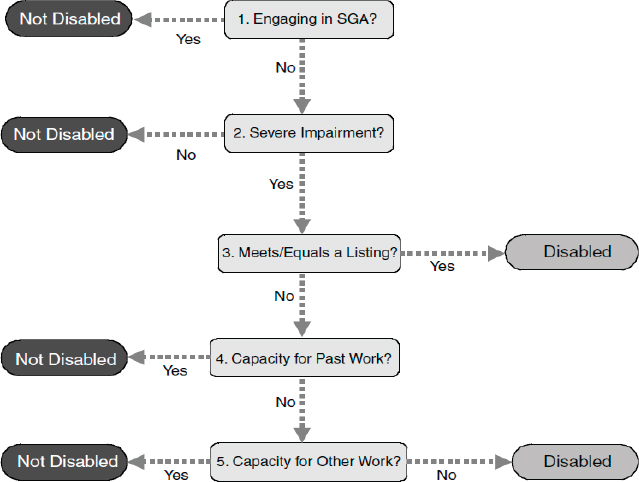
NOTE: SGA = substantial gainful activity.
SOURCES: NASEM, 2018; 20 CFR § 404.1520, 416.920, and 401.1525 (2012).
- be approved and benefits are awarded (see 20 CFR § 404.1560(c) (1996)).4
SSA considers function at several points in the disability determination process. As noted in Functional Assessment for Adults with Disabilities (NASEM, 2019, p. 25):
Functional criteria are built into a number of the adult listings in the Listing of Impairments considered at step 3. These listings include both impairments and limitations in activity, using the ICF terminology. SSA also considers function in its assessment of claimants’ physical and/or mental residual functional capacity (RFC) at steps 4 and 5. In some cases, RFC, particularly mental RFC, is a refinement of activity performance taken from the Listing of Impairments.
___________________
4 For additional details on the types of medical evidence considered in the disability determination process and on the training and credentials required of disability adjudicators and medical/psychologic consultants, refer to The Promise of Assistive Technology to Enhance Activity and Work Participation (NASEM, 2017).
Listing of Impairments
The third step of the evaluation process relies on the Listing of Impairments: Adult Listings (Part A)5 to identify claims that can be allowed regardless of the claimant’s age, education, or work experience. The 14 listings for adults, given in Box 2-1, are further categorized as to impairments that SSA considers severe enough to prevent an adult from performing any gainful activity, if listed criteria are met.
The listings for adult cancers (13.00), which were last updated in 2015, are shown in Figure 2-3. SSA considers many factors in evaluating cancer claims under the listings, including origin of the cancer; extent of involvement, duration, frequency, and response to anticancer therapy; and effects of any post-therapeutic residuals (SSA, 2015).
According to the SSA Office of the Inspector General (OIG, 2015, p. 1), “the Listings help ensure that disability determinations are medically sound, claimants receive equal treatment based on the specific criteria, and disabled individuals can be readily identified and awarded benefits, if appropriate.” The National Academies report Health-Care Utilization as a Proxy in Disability Determination (NASEM, 2018) found that although there has been an established “listing of medical impairments” since the disability program began in 1956, SSA did not publish the listings in its disability regulations
___________________
5 Found at 20 CFR Part 404, Subpart P, Appendix 1 (2012).
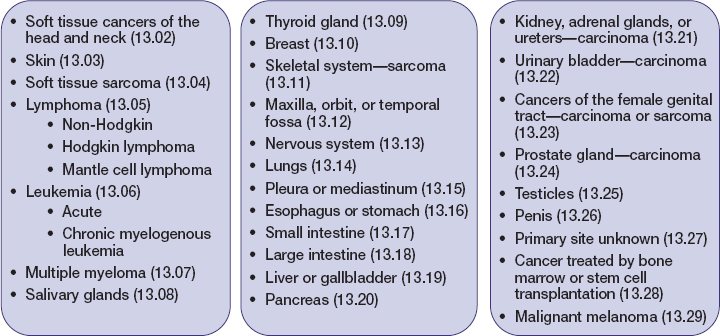
SOURCE: SSA, 2020b.
until 1968.6 Since then it has revised the listings periodically to reflect advances in medical knowledge. In 2003, SSA implemented a new process for revising the listings, which was designed to ensure their continuous updates and monitoring about every 3–4 years (NASEM, 2018; OIG, 2009).
The historic focus on cancer mortality and survival rates is reflected in SSA’s approach to the current listings, which are focused predominately on terminal and metastatic cancers with a high likelihood of death. Given the growing numbers of individuals benefiting from life-prolonging cancer treatment, these listings may not reflect the substantial advances in cancer treatment and improved survival that have occurred over the past few decades. In later chapters of this report, the committee discusses how cancer and cancer-related treatments (even if successful) can cause physical, psychological, or psychosocial impairments for cancer survivors. These cancer-related impairments may occur immediately (acute effects) or at some point in the future (late-onset effects), or acute effects may become chronic (long-term effects). Furthermore, impairments may occur individually or in clusters, and one impairment may exacerbate another (e.g., pain may make it difficult to sleep). These impairments may limit a survivor’s ability to function to varying degrees and, in some cases, may cause a survivor to seek disability benefits. In the future it may be possible to more directly consider functional limitations in the cancer listings.7Chapter 9 provides an extensive discussion of cancer-related impairments that may lead to functional limitations.
___________________
6 See https://secure.ssa.gov/poms.nsf/lnx/0434101005 (accessed September 4, 2020) for an explanation of the Listing of Impairments before 1968 (SSA, 1990).
7 This sentence was modified after release of the prepublication version of the report to clarify and more accurately reflect SSA’s use of the listing criteria.
U.S. SOCIAL SECURITY ADMINISTRATION CANCER CLAIMS DATA
Between 2015 and 2019 the total disability claims awarded by SSA for any disability decreased from 2,220,153 to 1,849,027 (17% decrease overall). During this time the number of awards for which cancer was given as the primary impairment also steadily decreased—from 125,904 to 114,187 (9% decrease overall); claims for a primary diagnosis of cancer made up about 6% of all disability claims in 2019 (Personal communication, Vincent Nibali, policy analyst, U.S. Social Security Administration, April 30, 2020). In this section the committee presents SSA data on disability claims for which cancer was the primary diagnosis.
Common Cancer Diagnoses in SSA Claims
Table 2-1 lists the 10 most common cancers for which SSA received disability claims in 2019, ranked by their frequency. Breast cancer accounted for the largest percentage of SSA disability cancer claims (16%), followed by lung cancer (14%) and colorectal cancer (12%).
The top 10 primary cancer impairments codes for which SSA awarded disability claims (i.e., allowances) from 2015 to 2019 are shown in Figure 2-4. The figure shows that the number of claims awarded for each type
TABLE 2-1 10 Most Common Cancers Listed in Disability Claims Received by SSA in 2019 (out of 114,187 claims with cancer as the primary impairment code and 1,849,027 total claims)
| Impairment | SSA Disability Claims | |
|---|---|---|
| % of All Cancer Claims | % of Total Claims | |
| Breast cancer | 16 | 1.0 |
| Lung cancer | 14 | 0.9 |
| Colorectal cancers | 12 | 0.7 |
| Head and neck cancers | 5 | 0.3 |
| Pancreatic cancer | 5 | 0.3 |
| Nervous system cancers | 5 | 0.3 |
| Leukemia | 5 | 0.3 |
| Lymphoma | 5 | 0.3 |
| Liver or bile ducts cancer | 3 | 0.2 |
| Ovarian cancer | 3 | 0.2 |
SOURCE: Personal communication, Vincent Nibali, policy analyst, U.S. Social Security Administration, April 30, 2020.
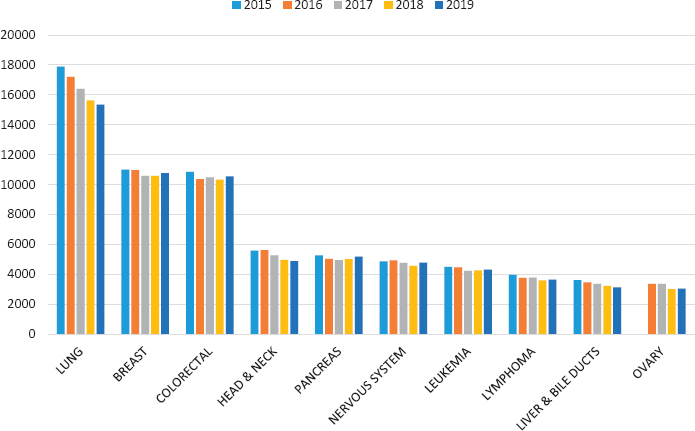
NOTES: lung = malignant neoplasm of trachea, bronchus, or lung (code 1620); breast = malignant neoplasm of breast (1740); colorectal = malignant neoplasm of colon, rectum, or anus (1530); head and neck = soft tissue tumors of head and neck (1950); pancreas = malignant neoplasm of pancreas (1570); nervous system = malignant neoplasm of nervous system (1910); liver and bile ducts = malignant neoplasm of liver and bile ducts (1550); ovary = malignant neoplasm of ovary (1830). The impairment code for leukemia is 2070 and for lymphoma is 2020.
SOURCE: Personal communication, Vincent Nibali, policy analyst, U.S. Social Security Administration, April 30, 2020.
of cancer have been generally consistent over the past 5 years, with lung, breast, and colorectal cancers being considerably more frequent than the other types of cancer. Of note, of the primary cancers only the number of claims awarded for lung cancer declined significantly (14%) during this time.
The listings in Figure 2-3 are not mutually exclusive; an individual may be diagnosed with a cancer, but may also qualify for disability under a different body system listing, or have a secondary impairment covered by another body system listing (see Box 2-1). In 2019 there were 4,241 allowances where cancer was listed as the secondary diagnosis and the primary impairment was listed under another body system. The most common body system where cancer was a secondary diagnosis was the musculoskeletal system, at 1,196 claims, followed by the neurological disorders listing (556
claims), the respiratory system listing (489), the cardiovascular system listings (362), and the mental disorders listing (332).
Table 2-2 shows the claims and allowances by step in the disability evaluation process for the top 10 cancers in 2019, as ranked by number of claims. Although breast cancer had the largest number of claims, lung cancer had the largest number of allowances in 2019, at 15,323 with an acceptance rate of 95.3%, compared with an acceptance rate of 59.3% for breast cancer. Allowances (i.e., awarded claims) occur predominately at step 3 when an individual’s condition has been judged to meet the conditions of a medical listing. Among the top 10 SSA cancers, more than 89% of allowances are made at step 3 (the exception is lymphoma with an allowance rate of 79%) (see Table 2-2). More than 92% of claims for cancers of the lung, pancreas, nervous system, and liver and bile duct are allowed, with the majority of these allowances occurring in step 3 by meeting a medical listing. All of these cancers are on the List of Compassionate Allowance Conditions (SSA, 2020a).
The lowest percentage of allowances (and highest percentage of claim denials) are for breast cancer (59.3%) and lymphoma (58.7%). The majority of these denials occur because SSA has found that the claimant’s impairment or combination of impairments is not severe enough to limit his or
TABLE 2-2 Claims and Allowances by Step in the SSA Disability Evaluation Process
| Primary Diagnosis | Claims Received | Allowances (% award rate) | Denied Claims (% denial rate) | Step at Which Allowance Occurs (% acceptance) | |
|---|---|---|---|---|---|
| Step 3 | Step 5 | ||||
| Lung | 16,074 | 15,323 (95.3) | 751 (4.7) | 14,826 (96.8) | 497 (3.2) |
| Breast | 18,095 | 10,724 (59.3) | 7,371 (40.7) | 9,552 (89.1) | 1,172 (10.9) |
| Colorectal | 13,693 | 10,524 (76.9) | 3,169 (23.1) | 9,414 (89.5) | 1,110 (10.6) |
| Pancreas | 5,312 | 5,172 (97.4) | 140 (2.6) | 5,132 (99.2) | 40 (0.8) |
| Head and neck | 5,534 | 4,857 (87.8) | 677 (12.2) | 4,629 (95.3) | 228 (4.7) |
| Nervous system | 5,168 | 4,775 (92.4) | 393 (7.6) | 4,654 (97.5) | 121 (2.5) |
| Leukemia | 5,270 | 4,301 (81.6) | 969 (18.4) | 3,972 (92.4) | 329 (7.7) |
| Lymphoma | 6,191 | 3,633 (58.7) | 2,558 (41.3) | 2,876 (79.2) | 757 (20.8) |
| Liver and bile ducts | 3,181 | 3,116 (98) | 65 (2) | 3,092 (99.2) | 24 (0.8) |
| Ovary | 3,563 | 3,043 (85.4) | 520 (14.6) | 2,979 (97.9) | 64 (2.1) |
| TOTAL | 82,081 | 65,468 | 16,613 | 61,126 | 4,342 |
SOURCE: Personal communication, Vincent Nibali, policy analyst, U.S. Social Security Administration, April 30, 2020.
her ability to do any basic work activities, has not lasted or is unlikely to last at least 12 months, or is not expected to result in death. The majority of the denials occur at step 2.
Breast and Lung Cancer Allowances
SSA specifically called out breast cancer and lung cancer as of interest in the committee’s Statement of Task (see Chapter 1) as these two cancers have the largest number of claims among cancers. Between 2015 and 2019 both the number of claims and allowances dropped for lung cancer, but for breast cancer only the number of claims dropped, while the number of allowances remained constant (see Figure 2-5).
Breast Cancer
SSA evaluates breast cancer under listing 13.10. In order to receive an allowance in step 3, the claimant must qualify for one of the 13.10 sublistings shown in Box 2-2.
Figure 2-6 shows that the breast cancer allowances in step 3 by year and sublisting have remained relatively constant from 2015 to 2019. The majority of allowances (about 66%) are for metastatic breast cancer (13.10B), while about 19% are for local advanced breast cancer (13.10A), and about 10% are for recurrent disease (13.10C). Very few allowances were given for small-cell breast cancer (13.10D; 7–11 allowances annually, 9 in 2019)—a
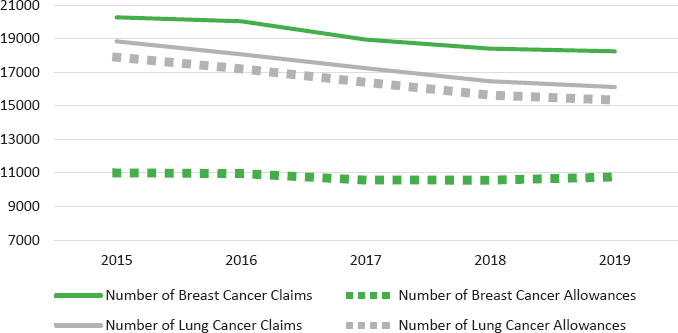
SOURCE: Personal communication, Vincent Nibali, policy analyst, U.S. Social Security Administration, April 30, 2020.
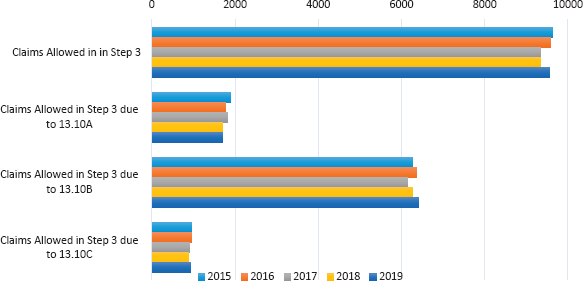
SOURCE: Personal communication, Vincent Nibali, policy analyst, U.S. Social Security Administration, April 30, 2020.
rare disease in both SSA claims data and in the general population—or for secondary lymphedema caused by breast cancer treatment (13.10E; 5–24 allowances annually, 14 in 2019). The committee notes that sublisting 13.10E (secondary lymphedema) is the only impairment caused by treatment in the cancer listings.
Lung Cancer
SSA evaluates lung cancer under listing 13.14. In order to receive an allowance in step 3 for lung cancer, the claimant must qualify for one of the sublistings in 13.14 (see Box 2-3).
Figure 2-7 shows the lung cancer allowances in step 3 by year and sublisting for 2015–2019. In 2019 the majority of the allowances (76%) in step 3 were for non-small-cell carcinoma (13.14A), followed by 18% of allowances for small-cell carcinoma (13.14B). Very rarely (<1%) is an claim allowed for carcinoma of the superior sulcus (13.14C) (120–142 allowances annually, 120 in 2019) (data not shown in Figure 2-7). The committee notes that although the number of allowances for non-small-cell lung cancer consistently dropped between 2015 and 2019, the number of allowances for small-cell lung cancer have remained about the same.
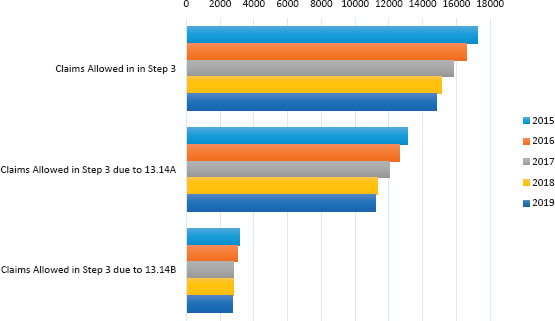
SOURCE: Personal communication, Vincent Nibali, policy analyst, U.S. Social Security Administration, April 30, 2020.
FINDINGS AND CONCLUSION
Findings
- SSA’s current Listing of Impairments focuses predominantly on terminal and metastatic cancers with a high likelihood of death and do not include, for the most part, impairments and functional limitations that may result from cancer treatments.
- In 2019 disability claims awarded with cancer as the primary diagnosis represented 6% of all SSA disability awards.
- From 2014 to 2019, there was a steady decrease in the total number of SSA disability claims as well as in claims with cancer as the primary diagnosis.
- From 2015 to 2019, breast cancer was the most common primary cancer diagnosis among disability claims received by SSA; however, the allowance rate for those claims was only 59.3% in 2019. The number of claims for breast cancer decreased by 10% during this period, although the number of allowances given each year remained virtually unchanged. In 2019 the majority (66%) were for metastatic breast cancer, with only 19% for locally advanced breast cancer and 10% for recurrent breast cancer.
- From 2015 to 2019, lung cancer was the second most common primary cancer diagnosis among disability claims received by SSA, but the most common cancer for which allowances were given (95.3% allowance rate in 2019). The number of claims and allowances
- for lung cancer decreased during this period by 14% and 10%, respectively. In 2019 the majority of the allowances (76%) were for non-small-cell carcinoma, with allowances for small-cell carcinoma the next most common (18%).
Conclusion
- SSA’s current cancer disability listings for adults focus on the most severe terminal and metastatic cancers with a high likelihood of death, and will not always capture more complex cancer cases that necessitate functional analysis. Such complex cases have become more common because of the growing number of cancer survivors who are benefiting from life-prolonging cancer treatments but who also may have impairments and functional limitations from those treatments.8
REFERENCES
IOM (Institute of Medicine). 2006. Workshop on disability in America: A new look: Summary and background papers. Washington, DC: The National Academies Press.
IOM and NRC (National Research Council). 2002. The dynamics of disability: Measuring and monitoring disability for Social Security programs. Washington, DC: National Academy Press.
NASEM (National Academies of Sciences, Engineering, and Medicine). 2017. The promise of assistive technology to enhance activity and work participation. Washington, DC: The National Academies Press.
NASEM. 2018. Health-care utilization as a proxy in disability determination. Washington, DC: The National Academies Press.
NASEM. 2019. Functional assessment for adults with disabilities. Washington, DC: The National Academies Press.
NASEM. 2020. Selected health conditions and likelihood of improvement with treatment. Washington, DC: The National Academies Press.
OIG (Office of the Inspector General). 2009. The Social Security Administration’s listing of impairments audit report a-01-08-18023. https://oig.ssa.gov/sites/default/files/audit/full/html/A-01-08-18023_7.html (accessed June 1, 2020).
OIG. 2015. Evaluation report: The Social Security Administration’s listing of impairments. https://oig.ssa.gov/sites/default/files/audit/full/pdf/A-01-15-50022.pdf (accessed June 1, 2020).
SSA (U.S. Social Security Administration). 1990. DI 34101.005 Listing of impairments prior to August 1968—explanation. https://secure.ssa.gov/poms.nsf/lnx/0434101005 (accessed September 4, 2020).
___________________
8 This text has changed since the release of the prepublication version of this report to clarify SSA’s current disability listings and why the listings might need to change in the future due to the complex nature of cancers and cancer treatments.
SSA. 2015. 13.00-malignant neoplastic diseases—adult. https://www.ssa.gov/disability/professionals/bluebook/13.00-NeoplasticDiseases-Malignant-Adult.htm (accessed January 16, 2020).
SSA. 2020a. Compassionate allowances. https://www.ssa.gov/compassionateallowances (accessed June 1, 2020).
SSA. 2020b. Presentation to the Committee on Diagnosing and Treating Adult Cancers by Alayna Ness, Supervisory Social Insurance Specialist, Social Security Administration, January 7, Washington, DC.
SSA. 2020c. Substantial gainful activity. https://www.ssa.gov/oact/cola/sga.html (accessed January 15, 2020).
SSA. 2020d. Understanding Supplemental Security Income SSI and other government programs. https://www.ssa.gov/ssi/text-other-ussi.htm (accessed June 1, 2020).
WHO (World Health Organization). 2001. International classification of functioning, disability and health. Geneva, Switzerland: World Health Organization.
















